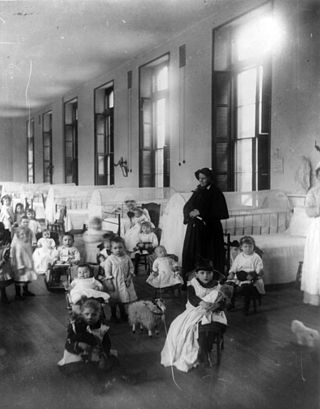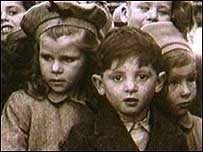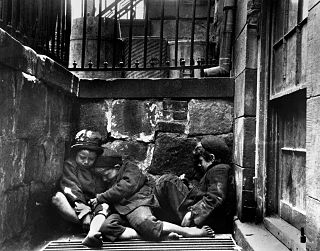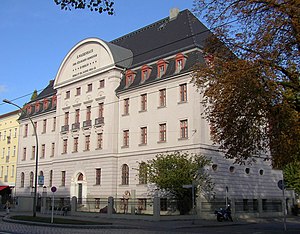
Adoption is a process whereby a person assumes the parenting of another, usually a child, from that person's biological or legal parent or parents. Legal adoptions permanently transfer all rights and responsibilities, along with filiation, from the biological parents to the adoptive parents.

An orphanage is a residential institution, total institution or group home, devoted to the care of orphans and children who, for various reasons, cannot be cared for by their biological families. The parents may be deceased, absent, or abusive. There may be substance abuse or mental illness in the biological home, or the parent may simply be unwilling to care for the child. The legal responsibility for the support of abandoned children differs from country to country, and within countries. Government-run orphanages have been phased out in most developed countries during the latter half of the 20th century but continue to operate in many other regions internationally. It is now generally accepted that orphanages are detrimental to the emotional wellbeing of children, and government support goes instead towards supporting the family unit.

Foster care is a system in which a minor has been placed into a ward, group home, or private home of a state-certified caregiver, referred to as a "foster parent", or with a family member approved by the state. The placement of a "foster child" is normally arranged through the government or a social service agency. The institution, group home, or foster parent is compensated for expenses unless with a family member.
The international adoption of South Korean children was at first started as a result of a large number of orphaned mixed children from the Korean War after 1953, but later included orphaned Korean children. Religious organizations in the United States, Australia, and many Western European nations slowly developed into the apparatus that sustained international adoption as a socially integrated system. This system, however, is essentially gone as of 2020. The number of children given for adoption is lower than in comparable OECD countries of a similar size, the majority of adoptees are adopted by South Korean families, and the number of international adoptees is at a historical low.

Street children are poor or homeless children who live on the streets of a city, town, or village. Homeless youth are often called street kids, or urchins; the definition of street children is contested, but many practitioners and policymakers use UNICEF's concept of boys and girls, aged under 18 years, for whom "the street" has become home and/or their source of livelihood, and who are inadequately protected or supervised. Street girls are sometimes called gamines, a term that is also used for Colombian street children of either sex.
International adoption is a type of adoption in which an individual or couple residing in one country becomes the legal and permanent parent(s) of a child who is a national of another country. In general, prospective adoptive parents must meet the legal adoption requirements of their country of residence and those of the country whose nationality the child holds.

Trafficking of children is a form of human trafficking and is defined by the United Nations as the "recruitment, transportation, transfer, harboring, and/or receipt" kidnapping of a child for the purpose of slavery, forced labour, and exploitation. This definition is substantially wider than the same document's definition of "trafficking in persons". Children may also be trafficked for adoption.
Hope and Homes for Children (HHC) is a British registered charity operating and working with children, their families and communities in several countries in Central and Eastern Europe and Africa, to help children grow up in safe and productive environments. The charity moves children out of institutions into family-based care, helps keep together families who are at risk of breakdown due to the pressures of poverty, disease or conflict, and works to prevent child abandonment.

The Adoption and Safe Families Act was signed into law by President Bill Clinton on November 19, 1997, after having been approved by the United States Congress earlier in the month.
Child laundering is a tactic used in illegal or fraudulent international adoptions. It may involve child trafficking and child acquisition through payment, deceit or force. The children may then be held in sham orphanages while formal adoption processes are used to send them to adoptive parents in another country.
Family preservation was the movement to help keep children at home with their families rather than in foster homes or institutions. This movement was a reaction to the earlier policy of family breakup, which pulled children out of unfit homes. Extreme poverty alone was seen as a justified reason to remove children. This new movement began in the 1890s, and in the 1909 White House Conference on Children it was the top ranked issue. In order to keep families together, the family would be given enough money so that the mother would not have to work a full-time job. The families that were given this assistance were usually headed by widows.

An orphan is a child whose parents have died, are unknown or have permanently abandoned them. It can also refer to a child who has lost only one parent, as the Hebrew translation, for example, is "fatherless"
Child migration or "children in migration or mobility" is the movement of people ages 3–18 within or across political borders, with or without their parents or a legal guardian, to another country or region. They may travel with or without legal travel documents. They may arrive to the destination country as refugees, asylum seekers, or economic migrants.
Orphanhood in Romania became prevalent as a consequence of the Socialist Republic of Romania's pro-natality policy under Nicolae Ceaușescu. Its effectiveness led to an increase in birth rates at the expense of adequate family planning and reproductive rights. Its consequences were most felt with the collapse of the regime's social safety net during the Romanian austerity period, which led to widespread institutional neglect of the needs of orphans, with severe consequences in their health and well-being. A series of international and governmental interventions have taken place since the 1990s to improve the conditions in orphanages and reform the country's child protection system, with variable degrees of success.

Foster care is the term used for a system in which a minor who has been made a ward is placed in an institution, group home, relative placement, or private home of a state certified caregiver. The placement of the child is usually arranged through the government or a social-service agency. The institution, group home, or foster parent is paid. The state via the family court and child protection agency stand in loco parentis to the minor, making all legal decisions, while the foster parent is responsible for the day-to-day care of the minor. The foster parent is remunerated by the state for their services.

Tourism in Cambodia is one of the most important sectors in the country's economy. In 2013, tourism arrivals increased by 17.5 percent year on year, with business travelers increasing 47 percent.

Institutionalization of children with disabilities in Russia is the placement of children, who have been abandoned or whose parents cannot support them, into a facility which can be similar to an orphanage. This often occurs in countries where alternative methods of care are not available. The definition of an institution can be ambiguous; the "Report of the Ad Hoc Expert Group on the Transition from Institutional to Community-based Care" defines an institution based on the following guidelines:
Georgette Mulheir was the chief executive of Lumos, an international non-governmental organisation, founded in 2005 by J. K. Rowling to end the institutionalisation of orphaned children throughout the world, from 2011–2019. Her model of deinstitutionalisation, pioneered since 1993, has been followed in many countries across Eastern and central Europe.
Graham Windham is a private nonprofit in New York City that provides services to children and families. It was founded in 1806 by several prominent women, most notably Elizabeth Schuyler Hamilton. Since 2015, the organization has gained renewed attention because of the success of the Broadway musical Hamilton, in which the character of Eliza Hamilton describes the orphanage as her proudest achievement.

During the Russo-Ukrainian War, Russia has forcibly transferred thousands of Ukrainian children to areas under its control, assigned them Russian citizenship, forcibly adopted them into Russian families, and created obstacles for their reunification with their parents and homeland. The United Nations has stated that these deportations constitute war crimes. The International Criminal Court (ICC) has issued arrest warrants for President of Russia Vladimir Putin and Children's Rights Commissioner Maria Lvova-Belova for their alleged involvement. According to international law, including the 1948 Genocide Convention, such acts constitute genocide if done with intent to destroy, in whole or in part, a nation or ethnic group.











